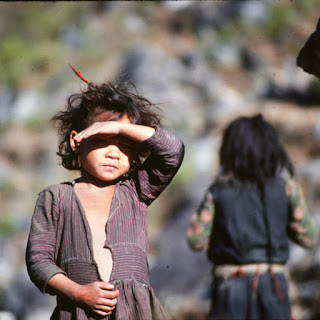 |
| One of our porters, carrying three tents with a tumpline. |
4 February 1981
Nuntale
Yesterday was dominated by my illness. I got a pretty serious case of diarrhea, probably from the shitty lunch stop by the river the day before, or perhaps from eating salami there -- it seemed to be a bit off. I took lomotil in the morning and it seemed to be fairly effective. Unfortunately, I misplaced the stuff and couldn't take the noon dose. At 3 PM, I dumped all that remained, with great pain.
The day for me was exhausting. Uphill walking made my head throb -- especially after lunch -- and Ingrid had to carry everything for a few hours in the afternoon. I only drank black tea until supper.
We began by climbing along the ridge line steeply above Sagar. There were a few houses along the way. These people don't seem to farm, but rather live off animals. We saw some magpies with beautifully long tails. After three hours walk, we reached our lunch stop at about 11,000 feet elevation. The stop was near a shepherd's house. A Tibetan monk came by and offered us a copper necklace for an outrageous Rs 1000 (Rs 100 seemed a fair price).
 |
| Prayer flags at Lamjura Pass |
After lunch, we climbed another 600 feet, then did a long traverse across a snowfield with rhododendrons everywhere. After 1.5 hours traverse, we descended (!) to Lamjura pass at 11,580 feet. From there we descended steeply, under cloudy skies, for an hour. As the terrain flattened, we walked out from under the clouds (they seemed to gather around peaks and along ridges in the afternoons). We did a long traverse to Junbesi, a large, interesting village. We sat inside a tea shop with Woody and Nancy Jo, then went on to camp, which was in a shady spot right alongside the river.
 |
| Our first great view of the mountains; Everest at left. |
As we came into Junbesi, we had excellent views of Numbur and some other peaks.
I spent the evening in the tent and ate only rice and soup for dinner.
This morning, I was feeling much better. Our morning hike climbed through pine forest east of Junbesi in the fog. We did a long traverse around the ridge separating Junbesi from Ringmo. As we rounded the southeast end, we got our first view of Everest. It is mostly black, far enough away to seem unimposing, and had a white plume near its top from blowing snow. We could also see Nuptse, a long, flat peak, and the southern face of Ama Dablam.
We continued our traverse northward, passing through Salung, where we stopped at the "Everest View Hotel." (!) Here, Woody and Nancy Jo were drinking chang, a fermented milky colored drink made, in this case, from corn mash.
Our lunch stop was by a river and Ingrid and I washed our hair in the icy water.
 |
| All the trekkers at our lunch stop near Ringmo. |
After lunch, we climbed through Ringmo, a beautiful village on a hillside with the appearance of a southern plantation. There are apple orchards here and we bought some apple rakshi (a distilled liquor).
 |
| Foggy conditions at the (closed) Trakshindo Cheese Factory. |
 |
| Fog shrouded stupa at Trakshindo Pass. |
We continued climbing toward the Trakshindo Pass, stopping along the way at a cheese factory that, unfortunately, was closed. We were treated, however, to the sight of two yellow-throated martens -- large, omnivorous mammals with black fur and yellow throats and about the size of anteaters.
 |
| Bill and Lhakpa Nurbu in the forest below Trakshindo Monastery |
At the pass, the clouds and fog were thick. The temperature was only 36 °F, very low for early afternoon. We descended via the Trakshindo Monastery, where we stopped to see the gompa. From there, the trail passed through a lovely wet forest land -- with the heavy fog, it appeared almost enchanted. The trail descended fairly steeply to Nuntale, our camping spot. This village is the most medieval that I've seen in Nepal. About 15 buildings line the trail. In one, a woman was grinding corn using a hand spun millstone. There is a rack of drying corn in the middle of the village and a chicken sits atop it eating kernels. (The rack is 10 feet high. How did the chicken get up there?) Two young men chase a pig and catch it by a rear leg and pull it screaming into its pen for the night.











































